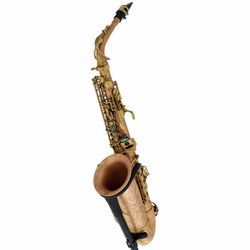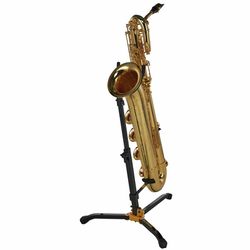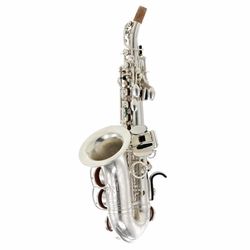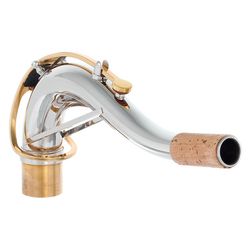How is the saxophone constructed?
Mouthpiece
Saxophone mouthpieces are available in various sizes and with a variety of tip openings which are finely graduated from small through to large to suit different playing styles. Trying different mouthpieces is the best way to find the perfect match. Narrower openings are ideal for classical saxophone music. French manufacturers such as Selmer and Vandoren are renowned for their high-quality mouthpieces, while a broad selection of brands cater to popular styles such as Pop and Jazz, offering a diverse range of mouthpiece options. Beginners often achieve quick, satisfactory results with Yamaha's C4 or C5 standard mouthpieces.
Tuning the saxophone is also as simple as adjusting the position of the mouthpiece, which is pushed further onto or off the S-bow.
S-bow
The S-bow – usually a curved, conical tube – connects the mouthpiece to the body and significantly influences the sound and intonation of the saxophone. Players who do not wish to part with their favourite instrument can use different S-bows to change the respective sound properties, using different S-bow materials, such as copper, silver, or gold brass, to alter the instrument's tone. Renowned manufacturers such as Yanagisawa, Selmer, and Yamaha offer various S-bow designs.
Body
The body of a saxophone consists of a conically expanding tube, typically made from brass, and features circular holes covered by keys. The keys are held in place by a metal spring-loaded mechanism. The body is usually lacquered, silver-plated, or nickel-plated, with professional models often featuring intricate engravings.
What accessories are available for the saxophone?
A padded case is typically included with every saxophone purchase.
Although highly portable, padded bags offer only limited protection for the instrument.
An essential accessory for saxophone players is a carrying strap, which attaches to the instrument via a hook. Many manufacturers include a carrying strap with the saxophone, though these are often only standard models. For added comfort, opt for carrying straps with a soft neck pad.
Shoulder straps, which allow the saxophone's phone to be distributed evenly across both shoulders and alleviate stress on the neck, are also recommended for children and larger saxophones.
To produce sound from a saxophone, you will need a reed, which is attached to the mouthpiece and primarily made from cane, although versions produced from synthetic materials are now also available. Reeds are available in strengths from 1 to 5, with the lowest strength indicating the softest reed. A lighter strength, such as the Vandoren Classic Blue, is ideal for beginners.
A variety of reed cases are available across all price ranges for storing your reeds.
The following accessories are essential for keeping your instrument in top working order: A pull-through swab for removing moisture – the presence of which can cause damage to the pads – from inside the saxophone. The use of a pull-through swab for the S-bow is also highly recommended. Keep the exterior of your instrument clean with a microfibre cloth and apply cork grease regularly around the cork to keep the mouthpiece joint supple.
The saxophone in Jazz, Pop, and Classical music
The extensive range of saxophone brands available today makes it difficult to quickly choose the right instrument at first glance. However, as most manufacturers focus on sounds suited to Jazz and Pop music, only a few saxophones, such as those by Selmer or Buffet Crampon, are tailored to a Classical tone aesthetic.
As with mouthpieces, the best way to find the right saxophone for you is by testing and playing different models.









)
)